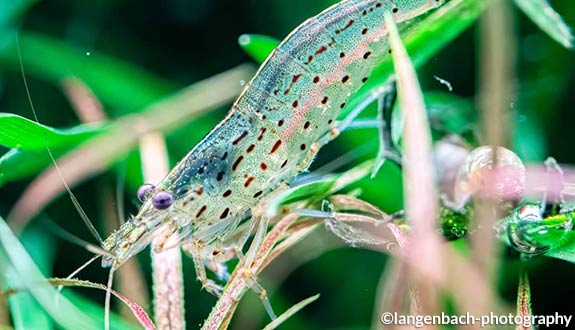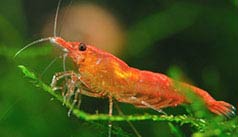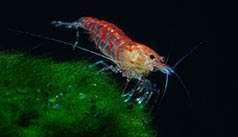

Alternative species (click on the thumbnail to see the card)
Names
Scientific name
Caridina multidentata
Caridina japonica (anciennement)
Common name
Amano Shrimp
Japanese Swamp Shrimp
Yamato Numa-Ebi
Algae Shrimp
Origin

Origin: Japan
Biotope: not-specific
Dimorphism

The female is significantly larger and thicker than the male.
Group
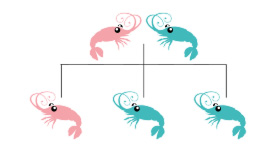
Atyidae
Volume

60 L / 13 Imp Gal / 16 US Gal
Parameters

T°: 20 to 28°C or 68 to 82°F
pH: 6.5 to 8
Hardness: 5 to 15°dGH
Difficulty

Easy
Size
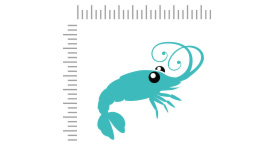
Male: 3.5cm-1.4" / Female: 5cm-2"
Longevity
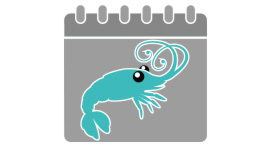
3 to 4 years
Living zone

Depth
Individuals
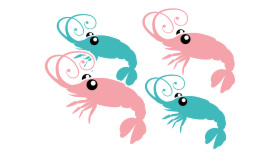
10
Food
How to feed the Amano shrimp?
Food
How to feed the Amano shrimp?
This crustacean, although omnivorous, feeds mainly on algae that it finds in its environment autonomously in the scenery. The Amano shrimp is also a detritivorous animal. Therefore, it will not hesitate to eat the leftovers of fish meals, or even to get rid of corpses!
However, if you have a large group of shrimp (or if you want to give them a little treat), it is advisable to supplement this food by distributing spirulina on the bottom shelf for example, or any other shrimp food.
Behavior
What kind of behavior does the Amano shrimp have?
Behavior
What kind of behavior does the Amano shrimp have?
In general, this shrimp is very active and moves either by walking or swimming!
If the shrimp is sufficiently nourished and well maintained, it will moult once a month (or after each water change). This moult is necessary for the growth of the shrimp. It gets rid of its old shell (molt) and a new one is formed. After moulting, the shrimp remains hidden for a long time because the new shell takes a while to harden, making it very vulnerable to predators.
Cohabitation
Who can live with the Amano shrimp?
Cohabitation
Who can live with the Amano Shrimp?
Like many shrimp, the Amano shrimp has a developed gregarious instinct and must be kept in groups. In the wild, these groups can reach hundreds of individuals! In aquariums, the strict minimum will be 10 specimens in an aquarium of at least 60 liters. Isolated or small numbers of shrimp tend to reduce their activities and remain constantly hidden.
It is preferable that the Amano shrimp is the only species of shrimp in the aquarium because it can be intimidated by the presence of other crustaceans.
For the rest of the cohabitations, especially with fish, there are no particular problems to report apart from the predation of certain species and the presence of large species which tends to intimidate the shrimp (it will then remain hidden most of the time).
Breeding
How to breed the Amano shrimp?
Breeding
How to breed the Amano shrimp?
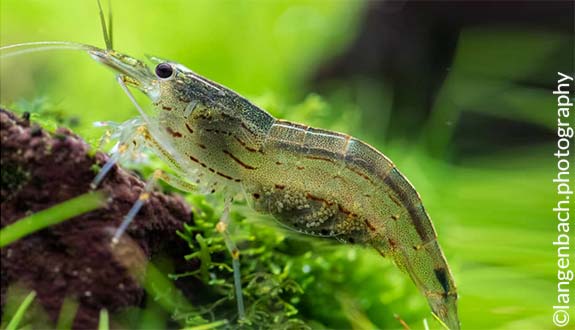
The breeding of this shrimp is difficult but achievable. Indeed, the larvae must go through a stage in salt water to develop.
The female is fecund immediately after its moult. She will then carry under her abdomen her eggs for 4 weeks.
If you wish to breed juveniles, prepare two small aquariums of about twenty liters. One will be in fresh water (identical to the main aquarium) and the other in sea water (salinity 33 to 34 g/l). For the freshwater aquarium, put some Java moss and green water (loaded with algae) so that the larvae can feed during the first days. For the saltwater aquarium, start a culture of phytoplankton (Dunaliella salina). For each tank, a few drops of fertilizer will allow you to obtain beautiful and appetizing algae!
Once your small tanks are ready, isolate the seeded female in the freshwater aquarium at the end of the incubation period. Once the young have been expelled, you can remove the female. Leave the larvae in this aquarium for 3 to 5 days and then transfer them to the seawater aquarium by acclimatizing them. The phytoplankton strain will then be used as food. It is also possible to use commercially available phytoplankton products for corals but this solution tends to pollute the tank a lot. If you opt for this solution, pay attention to the quality of your water and change it regularly (keeping the same salinity parameters).
This phase will last 20 days. The larvae will go through different stages of development and moulting. Finally, they will look like their parents, in a very small size! When they are 5 mm (0.2") in size and able to move around by walking, they will go through the last stage.
The young shrimp must now move to fresh water. To do this, make small water changes very regularly with fresh water so that the salinity drops. Spread this process over 3 or 4 days until the water becomes fresh. From then on, they are able to feed like adults. As soon as their size permits, release your young shrimp into the main aquarium.
Its aquarium
Which aquarium for the Amano shrimp?
Its aquarium
Which aquarium for the Amano shrimp?
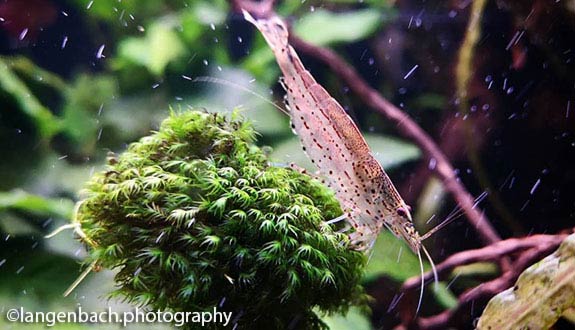
Sensitive to nitrates, which should be kept as low as possible. The water quality must therefore be optimal. To achieve this, always install a filtration system and change part of the aquarium water regularly.
Due to its somewhat shy nature, this shrimp needs hiding places and shaded areas. For this purpose, install roots, stones and plant abundantly. Finally, the presence of decomposing tree leaves (catappa, oak, beech...) lining the bottom of the aquarium is ideal: it serves both as a hiding place and as food!
Good To know
Find all additional information!
Good To know
Find all additional information!
Until 2006, this shrimp was called Caridina japonica.
Its coloration, even if it remains mostly transparent, varies according to its environment and its food. It can vary from gray to brown, with touches of green.
Yours photos!
Comments
Sort by:
Please login to post comments
